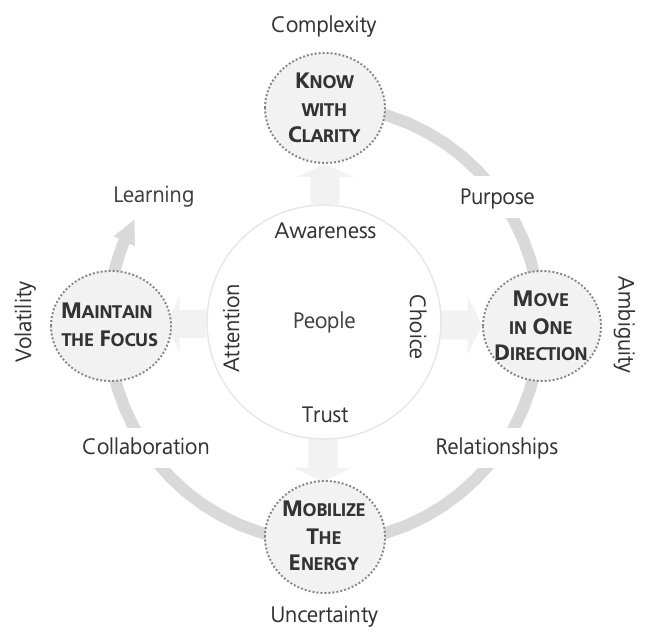
Four people-centric levers frame the operating system for 21st-century management. The levers offer a choice between the challenges an organization faces and the needs of the people that perform the work:

- The complexity and the clarity people need to be aware of what matters most
- The ambiguity and the direction people need to move in one direction
- The uncertainty and the energy people need to mobilize resources
- The volatility and the focus people need to maintain the attention on creating value
The four people-centric levers offer a choice between traditional and People-Centric Management:

Traditional management favours bureaucracy, power, command and targets. People-centric, on the other hand, is about self-responsibility, self-organization, delegation and attention. People-centric levers offer sliders with a choice that spans two operating modes. While sliders offer a choice, they often have an ambidextrous capacity. The sliders may indicate simultaneous use of both, or a mix of the two. For example, agility needs stability. A well-functioning managerial system serves as a stable platform. Agile without a stable platform is like a spring – it only works as a spring when it’s fixed on one end.
HOW DO WE KNOW WITH CLARITY?
Knowing with clarity identifies opportunities. It represents the capability to raise awareness, understand, and find purpose despite complexity. Lever 1 identifies how we help people understand and find purpose between traditional command styles and people-centric through self-responsibility.
In traditional command-oriented organizations, the goal is efficiency and reliability as the means to deliver shareholder value. Managers act as controllers and tell people what to do. In people-centric organizations, self-responsible teams delight their customers. With people-centric, the management task is to help people find purpose with customers first.
When knowledge is located with managers, command refers to the practice of them using information and routines to identify opportunities and offer direction. Command tends to increase complexity rather than supporting people’s efforts to cope with it. Traditional management uses instruction for people to understand and follow direction. But purpose is found, not given. With distributed knowledge, people-centric promotes self-responsibility with people who are aware, and able to identify opportunities and find meaning in what they do.
Purpose defines the meaning people attach to what they do. Knowing with clarity helps people understand, filter opportunities and, ultimately, find purpose. With this, they’re able to deal with complexity and create value for their customers.
HOW DO WE MOVE IN ONE DIRECTION?
To move in one direction is the ability to select valuable opportunities. Choice requires the alignment of forces and connecting people around purpose and direction, despite ambiguity. Lever 2 identifies how people align to form teams between applying traditional power and dynamic delegation.
In traditional organizations, power sits with managers who have people reporting to them. The relationship is between the manager and the employee. With a dynamic operating system, responsibility is delegated to teams at the client front. The role of the manager now is to offer direction and a supportive work environment.
With knowledge concentrated at the top, managers use power to tell people what the direction is and what the expectations are in following it. Power limits the use of knowledge in selecting the right opportunities when dealing with an ambiguous context. Traditional management applies power by using rules that help managers select valuable opportunities. With distributed knowledge, managers use systems to delegate the decision-making to where the knowledge is. Choice helps people select valuable opportunities and identify the direction.
Relationships define how people connect and align with each other to increase their knowledge and access capabilities to get work done. People who move in one direction make meaningful choices. As such, they can cope with ambiguity and create value.
HOW DO WE MOBILIZE THE ENERGY?
Mobilizing the energy refers to how we turn opportunities into value. It is the capability to trust our own resources and those around us, and to get things done despite uncertainty. Lever 3 identifies how we mobilize the energy to collaborate between traditional bureaucracy and self-organization.
Bureaucracy reigns in traditional organizations, with work being coordinated by managers, rules and plans. With a dynamic operating system, self-organized teams coordinate and collaborate while being supported by people-centric leadership practices.
When knowledge is concentrated at the top, managers coordinate work through routines and by telling people what they should be doing. Bureaucracy pushes uncertainty aside rather than reducing it. Traditional management applies bureaucracy rather than trusting people. But trust is the fastest management concept yet devised. Knowledgeable people trust their own capabilities to get work done. As such, agile promotes self-organization with motivated people who work in teams and turn opportunities into value.
Collaboration defines how people mobilize resources to coordinate work. Mobilizing the energy helps people bundle their efforts. In doing so, they can handle uncertainty and create value.
HOW DO WE MAINTAIN THE FOCUS?
Maintaining the focus is about sticking with the chosen opportunity. It’s the capability to focus attention and learn despite volatility. Lever 4 identifies how we focus and learn between traditional target setting and people-centric paying attention.
Traditional organizations are preoccupied with tight performance targets and goal achievement for efficiency and reliability. People-centric teams use attention to maintain their focus on the customer, supported by transparency, learning, sharing and continuous improvement. Focus of attention is natural to people. It’s people centric.
When knowledge is concentrated at the top, managers apply tools with narrow targets to ensure that people stay on track, don’t get distracted and follow the chosen opportunity. Narrow targets function like detailed prescriptions and operating procedures. Targets cannot deal with volatility; they’re always off. And so, people follow instructions, miss targets often and don’t learn. With distributed knowledge, attention mobilizes the ability of people to constantly focus attention. Focus of attention is the clue to learning.
Learning refers to the means by which people pay attention, refocus when needed, and enhance knowledge to constantly learn and improve performance. With this, people cope with volatility and create value for their clients.
NEXT STEPS
After deciding on the four levers, with clarity on the principles, agile techniques as the means and dynamic operating systems, the next step is to align them with each other to maximize their impact, in line with the predominant operating mode, in response to the specific context.
By design, there are many possible combinations of these levers, achieved by simply moving the sliders. However, from our research we know that four combinations of capabilities are needed to cover most business cases.

For example, in a dynamic context with knowledge distributed throughout the organization, the enabling mode dominates. People-centric leadership and dynamic systems match.
In dynamic and enabling contexts, traditional rules-based management approaches are not effective. Under these conditions, enabling modes support fast decision-making and proactive, flexible action, which lead to robust outcomes.
Self-managed workgroups and wider spans of control decrease the importance of direct managerial influence and increase the interpersonal influence and lateral coordination to direct and motivate work. This requires peer control as the process, where peers direct attention, motivate and encourage performance.
Enabling mode organizations require people-centric managerial competencies and a talent base that favours creativity and continuous innovation. Learning, and access to knowledge through networks, is as essential as their approach to continuously reassessing their resource base. Change is ongoing, but not as a disruptive process. It is the dynamic systems capability that makes these organizations agile and nimble.
The people-centric shift is a transformation where no one has the answers on the specific tools and practices that make up an agile organization, dynamic systems and People-Centric Management. It’s a capability that requires individual design to fit it to the specific needs of the organization and its stakeholders. As such, the people-centric shift is a transformation that follows design thinking in three steps: Collectively raise awareness, act on insights and learn fast.
I strongly recommend that readers of People-Centric Management first perform the diagnostic. These insights raise their awareness and makes their choices visible. As such, they will learn fast and are able to make people-centric their competitive advantage.
Lukas Michel, People-Centric Management: How managers use four levers to bring out the greatness of others. LID Publishing, London, 2020, ISBN: 9781912555994
The research: Michel, L., Anzengruber, J., Wolfe, M., & Hixson, N. (2018). Under What Conditions do Rules-Based and Capability-Based Management Modes Dominate? Special Issue Risks in Financial and Real Estate Markets Journal, 6(32).
This blog was originally publish on the LID Publishing Blog.
Since 2002, we create twins of organizations with the AI-based operating system for dynamic leadership.
Management Insights is an independent and privately owned company with headquarters in Zuoz, Switzerland.
For more information, contact Lukas Michel, founder and author, or our partners across the world.
Experience the free TWIN.

